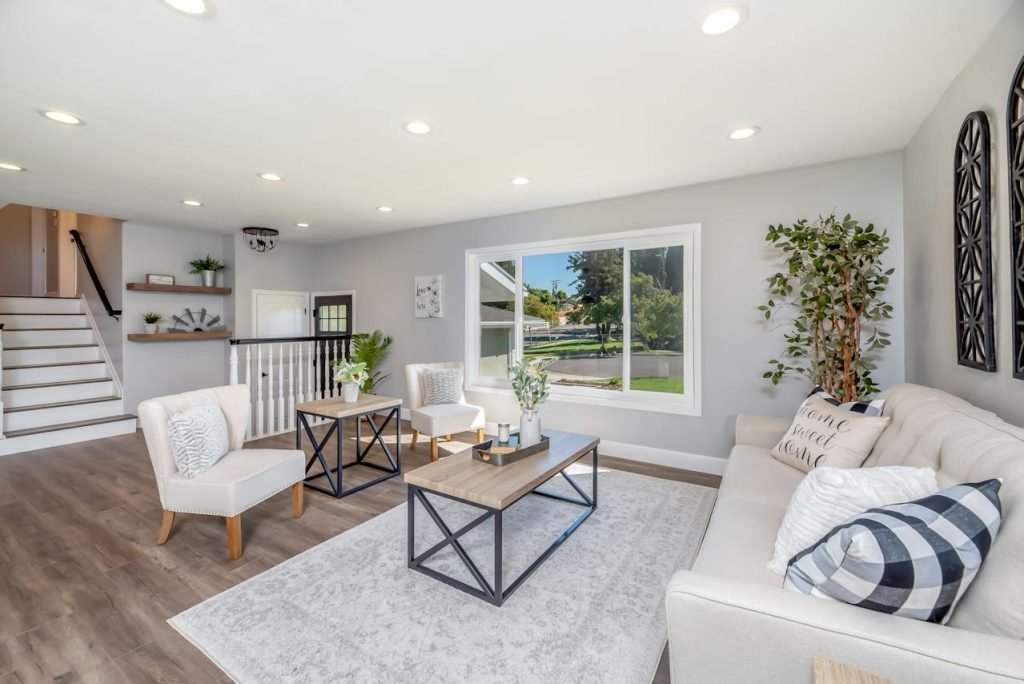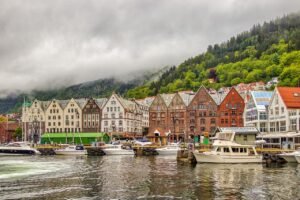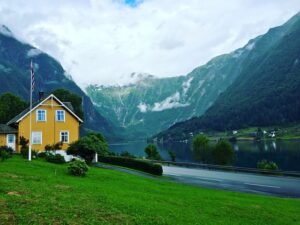

Navigating Norwegian Real Estate: Key Terms for Renters and Buyers | Learn Norwegian B1-B2
Navigating the complex world of Norwegian real estate can be a challenging yet rewarding experience. Whether you’re planning to rent a ‘leilighet’ in the bustling streets of Oslo or purchase a peaceful ‘enebolig’ in the fjords, understanding the key terms and concepts is crucial. This article provides an insight into essential Norwegian real estate vocabulary, complete with example sentences, to aid both renters and buyers in their property journey.
Table of Contents
Toggle1. Boligtyper: Types of Properties
In Norway, the term ‘bolig’ refers to various property types, each catering to different needs and lifestyles:
- Enebolig: A detached single-family home, offering more space and privacy.
- Example: “Vi drømmer om å kjøpe en enebolig med stor hage.” (We dream of buying a detached single-family home with a large garden.)
- Rekkehus: Row houses, known for their community feel.
- Leilighet: Apartments, commonly found in urban areas.
- Tomannsbolig: Duplexes, accommodating two families.
2. Leie vs. Kjøpe: Renting vs. Buying
The decision to ‘leie’ (rent) or ‘kjøpe’ (buy) depends on one’s personal situation and the housing market:
- Leie (Rent): Renting offers flexibility without the long-term commitment of property ownership.
- Example: “Hvor mye koster det å leie en leilighet i sentrum?” (How much does it cost to rent an apartment in the city center?)
- Kjøpe (Buy): Buying is an investment in property with long-term benefits.
- Example: “Vi planlegger å kjøpe et rekkehus neste år.” (We plan to buy a row house next year.)
3. Husleie og Leiekontrakt: Rent Costs and Rental Agreements
‘Husleie’ refers to the cost of renting a property. The ‘leiekontrakt’ is the rental agreement outlining the terms of rent:
- Example: “Husleien for denne leiligheten inkluderer varme og vann.” (The rent for this apartment includes heating and water.)
4. Kjøpskontrakt og Eiendomsskatt: Purchase Contract and Property Tax
A ‘kjøpskontrakt’ outlines the terms of a property sale. ‘Eiendomsskatt’ refers to the property tax that varies by location.
- Example: “Før vi signerer kjøpskontrakten, må vi gå gjennom alle detaljene nøye.” (Before we sign the purchase contract, we need to review all the details carefully.)
5. Eiendomsmegler: Real Estate Agents
An ‘eiendomsmegler’ is a certified real estate agent, crucial in the Norwegian property market.
- Example: “Vi brukte en erfaren eiendomsmegler for å finne vårt nye hjem.” (We used an experienced real estate agent to find our new home.)
6. Budrunde: The Bidding Round
‘Budrunde’ is the auction-style bidding process unique to Norway.
- Example: “Budrunden på huset var intens, men vi vant til slutt.” (The bidding round for the house was intense, but we eventually won.)
7. Felleskostnader og Borettslag: Common Expenses and Housing Cooperatives
‘Felleskostnader’ are the monthly fees for maintaining shared property spaces, especially in apartments and housing cooperatives (‘borettslag’).
- Example: “Felleskostnadene for leiligheten dekker bygningens vedlikehold.” (The common expenses for the apartment cover the building’s maintenance.)
8. Finansieringsbevis og Boliglån: Mortgage Pre-Approval and Home Loans
A ‘finansieringsbevis’ is a mortgage pre-approval document from a bank, indicating your borrowing capacity. ‘Boliglån’ are the mortgages you can take out.
- Example: “Vi fikk finansieringsbevis fra banken før vi startet boligsøket.” (We got mortgage pre-approval from the bank before we started house hunting.)
9. Boligforsikring: Home Insurance
‘Boligforsikring’ is necessary to protect your property against unforeseen damages.
- Example: “Det er viktig å ha en god boligforsikring i tilfelle skader.” (It’s important to have good home insurance in case of damages.)
10. Eierseksjon vs. Andelsbolig: Condominiums vs. Cooperative Housing
Understanding the difference between ‘eierseksjon’ (condominium ownership) and ‘andelsbolig’ (cooperative housing) is crucial for property buyers.
- Example: “Vi kjøpte en eierseksjon i et nytt boligkompleks.” (We bought a condominium in a new housing complex.)
Conclusion
Familiarizing yourself with these key Norwegian real estate terms and their practical usage in sentences will greatly assist you in navigating the property market, whether for renting or buying. It’s always advisable to seek guidance from ‘eiendomsmeglere’ and legal experts for a successful property experience in Norway.
FAQs
1. What is the significance of ‘Enebolig’ in the Norwegian property market?
- Answer: An ‘Enebolig’ signifies a detached single-family home in Norway, offering privacy and more space. It’s especially sought after by families looking for a standalone residence. Example: “Vi drømmer om å kjøpe en enebolig med stor hage,” meaning “We dream of buying a detached single-family home with a large garden,” highlights the desirability of such properties for their spaciousness and privacy.
2. How do the concepts of ‘Leie’ and ‘Kjøpe’ differ, and what are their implications for housing in Norway?
- Answer: ‘Leie’ (rent) and ‘Kjøpe’ (buy) represent two fundamentally different approaches to housing in Norway. Renting offers flexibility and less financial burden, suitable for those seeking short-term accommodation or avoiding the responsibilities of ownership. Buying, on the other hand, is a long-term investment, implying a commitment to property ownership and maintenance. For example, “Hvor mye koster det å leie en leilighet i sentrum?” (“How much does it cost to rent an apartment in the city center?”) reflects the renter’s concern for affordability and location, while “Vi planlegger å kjøpe et rekkehus neste år” (“We plan to buy a row house next year”) indicates a long-term investment mindset.
3. In what way does ‘Husleie’ impact tenants, and what should potential renters be aware of?
- Answer: ‘Husleie’ or rent cost is a crucial factor for tenants, as it determines their monthly financial commitment to housing. It’s important for renters to understand what the ‘Husleie’ covers, such as utilities and maintenance fees. The example sentence “Husleien for denne leiligheten inkluderer varme og vann” (“The rent for this apartment includes heating and water”) highlights the need to understand the components of rent to avoid unexpected expenses.
4. What is the importance of a ‘Kjøpskontrakt’ in property transactions, and what should buyers consider?
- Answer: A ‘Kjøpskontrakt’, or purchase contract, is a binding legal document in property transactions. It outlines the terms of sale, including price, property details, and responsibilities of both parties. Buyers must review this contract carefully to ensure they understand their commitments and rights. For example, “Før vi signerer kjøpskontrakten, må vi gå gjennom alle detaljene nøye” (“Before we sign the purchase contract, we need to review all the details carefully”) emphasizes the importance of due diligence in property transactions.
5. What role does an ‘Eiendomsmegler’ play in the Norwegian real estate market?
- Answer: An ‘Eiendomsmegler’ is a certified real estate agent, crucial for navigating the complex Norwegian property market. They assist in finding properties, negotiating deals, and understanding legal requirements. The sentence “Vi brukte en erfaren eiendomsmegler for å finne vårt nye hjem” (“We used an experienced real estate agent to find our new home”) illustrates the value of professional guidance in making informed real estate decisions.
6. How does the ‘Budrunde’ process work in Norway, and what strategies should buyers adopt?
- Answer: The ‘Budrunde’ is an auction-style bidding process unique to the Norwegian real estate market. Potential buyers submit their bids within a specified timeframe, often leading to competitive bidding. Understanding this process and having a strategy is vital for success in securing a property. The sentence “Budrunden på huset var intens, men vi vant til slutt” (“The bidding round for the house was intense, but we eventually won”) reflects the competitive nature of this process and the need for preparedness.
7. Can you explain the concept of ‘Felleskostnader’ and its relevance for property owners in Norway?
- Answer: ‘Felleskostnader’ refers to common expenses associated with property ownership, particularly in apartments and housing cooperatives. These fees cover maintenance, insurance, and sometimes utilities of shared spaces. Understanding these costs is essential for budgeting and assessing the total cost of ownership. “Felleskostnadene for leiligheten dekker bygningens vedlikehold” (“The common expenses for the apartment cover the building’s maintenance”) highlights the need to account for these expenses in addition to the purchase price.
8. What is the importance of obtaining a ‘Finansieringsbevis’ when looking to purchase property in Norway?
- Answer: A ‘Finansieringsbevis’, or mortgage pre-approval, is crucial in demonstrating a buyer’s financial capacity to sellers. It’s a document issued by a bank that indicates how much the bank is willing to lend. This pre-approval is often required before making an offer on a property. “Vi fikk finansieringsbevis fra banken før vi startet boligsøket” (“We got mortgage pre-approval from the bank before we started house hunting”) underscores the importance of financial preparedness in the property-buying process.
9. Why is ‘Boligforsikring’ essential for homeowners in Norway?
- Answer: ‘Boligforsikring’, or home insurance, is essential for protecting homeowners against potential damages and losses. It provides financial security in unforeseen circumstances, such as natural disasters or accidents. “Det er viktig å ha en god boligforsikring i tilfelle skader” (“It’s important to have good home insurance in case of damages”) illustrates the importance of having a safety net to protect one’s investment.
10. How do ‘Eierseksjon’ and ‘Andelsbolig’ differ, and what are the implications for buyers? – Answer: ‘Eierseksjon’ refers to condominium ownership, where individuals own a specific unit within a building, while ‘Andelsbolig’ is a form of cooperative housing where individuals own shares in a cooperative that owns the property. Each type has different rules regarding ownership, responsibility, and financing. “Vi kjøpte en eierseksjon i et nytt boligkompleks” (“We bought a condominium in a new housing complex”) exemplifies the individual ownership model of ‘Eierseksjon’, contrasting with the shared ownership model of ‘Andelsbolig’.
If you want to learn Norwegian, you can register for classes here. If you want to check your Norwegian level for free, you can do that here. We look forward to hearing from you and helping you become fluent in Norwegian!
Refer a friend and get $150.Join the program here
If you want to learn Norwegian, you can register for classes here. We look forward to hearing from you and helping you become fluent in Norwegian.





